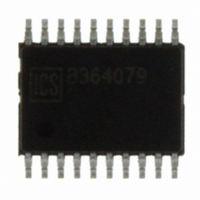ICS85356AGILF IDT, Integrated Device Technology Inc, ICS85356AGILF Datasheet - Page 6

ICS85356AGILF
Manufacturer Part Number
ICS85356AGILF
Description
IC CLK MUX 2:1 DIFF HS 20-TSSOP
Manufacturer
IDT, Integrated Device Technology Inc
Series
HiPerClockS™r
Type
Multiplexerr
Datasheet
1.ICS85356AGILF.pdf
(15 pages)
Specifications of ICS85356AGILF
Number Of Circuits
2
Ratio - Input:output
2:1
Differential - Input:output
Yes/Yes
Input
HCSL, LVDS, LVHSTL, LVPECL, SSTL
Output
LVPECL
Frequency - Max
900MHz
Voltage - Supply
3 V ~ 3.6 V
Operating Temperature
-40°C ~ 85°C
Mounting Type
Surface Mount
Package / Case
20-TSSOP
Frequency-max
900MHz
Number Of Clock Inputs
4/2
Mode Of Operation
Differential
Output Frequency
900MHz
Output Logic Level
ECL/LVPECL
Operating Supply Voltage (min)
-3/3V
Operating Supply Voltage (typ)
-3.3/3.3V
Operating Supply Voltage (max)
-3.8/3.6V
Package Type
TSSOP
Operating Temp Range
-40C to 85C
Operating Temperature Classification
Industrial
Mounting
Surface Mount
Pin Count
20
Lead Free Status / RoHS Status
Lead free / RoHS Compliant
Other names
800-1175
800-1175-5
800-1175
85356AGILF
800-1175-5
800-1175
85356AGILF
ICS85356I Data Sheet
Application Information
Wiring the Differential Input to Accept Single-Ended Levels
Figure 1 shows how a differential input can be wired to accept single
ended levels. The reference voltage V
the bias resistors R1 and R2. The bypass capacitor (C1) is used to
help filter noise on the DC bias. This bias circuit should be located as
close to the input pin as possible. The ratio of R1 and R2 might need
to be adjusted to position the V
swing. For example, if the input clock swing is 2.5V and V
R1 and R2 value should be adjusted to set V
below are for when both the single ended swing and V
same voltage. This configuration requires that the sum of the output
impedance of the driver (Ro) and the series resistance (Rs) equals
the transmission line impedance. In addition, matched termination at
the input will attenuate the signal in half. This can be done in one of
two ways. First, R3 and R4 in parallel should equal the transmission
Figure 1. Recommended Schematic for Wiring a Differential Input to Accept Single-ended Levels
Recommendations for Unused Input and Output Pins
Inputs:
CLK/nCLK Inputs
For applications not requiring the use of the differential input, both
CLK and nCLK can be left floating. Though not required, but for
additional protection, a 1kΩ resistor can be tied from CLK to ground.
Control Pins
All control pins have internal pull-ups or pull-downs; additional
resistance is not required but can be added for additional protection.
A 1kΩ resistor can be used.
ICS85356AMI REVISION B MAY 10, 2010
REF
in the center of the input voltage
REF
= V
REF
CC
at 1.25V. The values
/2 is generated by
CC
CC
are at the
= 3.3V,
6
line impedance. For most 50Ω applications, R3 and R4 can be 100Ω.
The values of the resistors can be increased to reduce the loading for
slower and weaker LVCMOS driver. When using single-ended
signaling, the noise rejection benefits of differential signaling are
reduced. Even though the differential input can handle full rail
LVCMOS signaling, it is recommended that the amplitude be
reduced. The datasheet specifies a lower differential amplitude,
however this only applies to differential signals. For single-ended
applications, the swing can be larger, however V
than -0.3V and V
of the recommended components might not be used, the pads
should be placed in the layout. They can be utilized for debugging
purposes. The datasheet specifications are characterized and
guaranteed by using a differential signal.
Inputs:
LVPECL Outputs
All unused LVPECL outputs can be left floating. We recommend that
there is no trace attached. Both sides of the differential output pair
should either be left floating or terminated.
2:1, DIFFERENTIAL-TO-3.3V LVPECL/ECL CLOCK MULTIPLEXER
IH
cannot be more than V
©2010 Integrated Device Technology, Inc.
CC
+ 0.3V. Though some
IL
cannot be less















